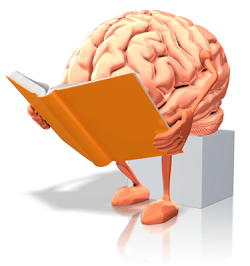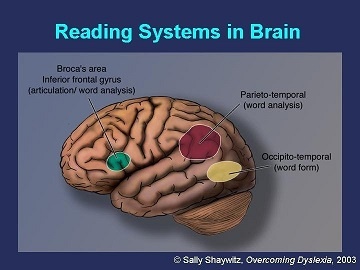Reading and the Brain

Recently I ran across two articles related to studying the reading brain:
- Learning to Read Does Not End in Fourth Grade by Abby Abrams, Time Magazine
- The Emerging Field of Educational Neuroscience in The Examiner (e-newsletter from the International Dyslexia Association- IDA)
Advances in this area are made every day, but unfortunately very little of what these researchers learn gets in the hands of educators in the field. So I decided to devote this post to providing links to resources about this fascinating topic of reading and the brain.
The Reading Matters to Maine website has some excellent resources, including a 90-minute video of a presentation by Christopher Kaufman called Reading and the Brain. His explanation of how the brain learns to read and implications for instruction is excellent and the information is readily comprehended by folks who are not neuroscientists!
If you have time to read a book on this topic, my favorite is Proust and the Squid: The Story and Science of the Reading Brain by Maryanne Wolf. Maryanne is the Director of the Center for Reading and Language Research at Tufts University where she and her colleagues study how the brain learns to read. I have the honor of being able to claim Maryanne as a friend and colleague, and she is one of the most passionate researchers about reading I know. You can access an interview with Maryanne at the Children of the Code website.
If you ever have an opportunity to hear Maryanne speak, you should go see her. One opportunity is to attend the Plain Talk About Literacy and Learning conference that is held annually in New Orleans. The 2015 conference will be held on February 9-11. I will also be presenting at the 2015 conference.
Stephanie Gottwald is a colleague of Maryanne’s at the Tufts center. You can access an excellent archived webinar title “Understanding the Neuroscience Behind Reading” sponsored by Voyager Sopris Learning. It’s about an hour long.
Sally Shaywitz and her husband Bennet direct The Yale Center for Dyslexia and Creativity, and they have long studied how advances in neuroscience can help us understand the connection between reading and the brain, especially as it relates to struggling readers. Despite being over 10 year old, Sally’s seminal book Overcoming Dyslexia is still an excellent resource, and includes visuals of brains undergoing fMRI (functional magnetic resonance imaging).
Here are some other links to learn more about reading and the brain:
- Video: Reading and the Brain, hosted by Henry Winkler (6 minutes, how brain imaging studies shed light on why some students struggle to read)
- See Brain. See Brain Read. Article

 Joan Sedita is the founder of Keys to Literacy and author of the Keys to Literacy professional development programs. She is an experienced educator, nationally recognized speaker and teacher trainer. She has worked for over 35 years in the literacy education field and has presented to thousands of teachers and related professionals at schools, colleges, clinics, and professional conferences.
Joan Sedita is the founder of Keys to Literacy and author of the Keys to Literacy professional development programs. She is an experienced educator, nationally recognized speaker and teacher trainer. She has worked for over 35 years in the literacy education field and has presented to thousands of teachers and related professionals at schools, colleges, clinics, and professional conferences.
Thanks for including all the links to resources, especially videos. I had not seen all of those.